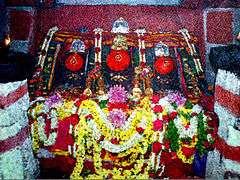Hasanamba temple
| Hasanamba Temple | |
|---|---|
 | |
 Hasanamba Temple Location within Karnataka | |
| Geography | |
| Coordinates | 13°00′09″N 76°05′36″E / 13.0024267°N 76.0933586°E |
| Country | India |
| State/province | Karnataka |
| District | Hassan |
| Locale | Hassan |
| Culture | |
| Primary deity | Sapthamathruke (7 sisters), Chamundi, Maheshwari, Vaishnavi, Indrani |
| Important festivals | deepavali |
| Architecture | |
| Architectural styles | Hoysala tradition of temple architecture |
Once when the seven Maatrukes (Brahmi, Maheshwari, Kaumari, Vyshnavi, Varahi, Indrani and Chamundi)[1] came floating to the South of India, they were taken aback by the beauty of Hassan and decided to make it their home forever. Maheshwari, Kaumari, and Vyshnavi took residence in the three anthills inside the temple; Brahmi in Kenchamma's Hosakote; while Indrani, Varahi and Chamundi chose the three wells in Devigere Honda.
The town Hassan was named after the presiding deity at the Hasanamba Temple.[2] She is called Hasanamba as she is perceived to be ever smiling, bestowing all riches on her devotees. Built in the 12th century, the temple is open to the public for a week, once a year during the lunar month of Ashwayuja, during deepavali in October. So devotees flock here to seek the Goddess’ blessings during this week. This is the best time to visit the temple.[3]
History
The temple is believed to have been constructed sometime around the 12th century, though no one knows exactly when or how it came to be. There is an ant-hill representing the presiding deity inside the temple premises and because the temple is open for only a week a year, it is all the more special to obtain a darshan during the Deepvali festival.[4][5]

Architecture
Archeological experts consider the Hasanamba Temple in Hassan to be the epitome of temple architecture in Karnataka. The city of Hassan dates back to the 11th century and the temples around Hassan signify the various dynasties that have ruled ever since the 11th century. It was originally built by the Hoysala dynasty in their tradition, reflecting their faith in Jainism. The temples in the Hassan district are some of the finest examples of the Hoysala tradition of temple architecture.
Religious Significance
The temple is unusual in that it is open to the devotees only for a week every year. The rest of the time the Goddess is left with a lit lamp, flowers, water and two bags of rice as offering until the next year. The nandaa deepa, (a ghee-lit lamp) burns all year round, for the entire duration when the temple doors are shut, with the ghee never depleting. And the anna naivedya (the rice offering) offered to the devi at the time of closing the temple is warm and unspoiled when the doors are opened again, a year later. its a great temple in hasana [6]

Mythology
The devotees believe that the benevolent Goddess smiles down upon them and showers her blessings. In many Indian languages, ‘hasya’ means humor. It is believed that the Goddess smiles down on the devotees who worship her.[7]

While she is worshipped for being benevolent, she is also harsh to those who choose to harm her devotees. There is a belief that Amma Hasanamba turned a mother in law, who tortured Devi’s devotee the (daughter in law), in to a stone in front of her. It is believed it the stone moves an inch every year and when it reaches the lotus feet of hasanamba the period of kaliyuga will end.
Once 4 robbers attempted to rob jewels of Hasanamba and Devi turned them in to stones. And these four stones can be still seen in Kallappa Gudi.
Facts
There is an unusual image depicting Ravana from the epic Ramayana with nine heads instead of ten, playing the veena. The reason for this image in the inner sanctum sanctorum is unknown but is very interesting nevertheless.
Just after devotees enter the temple they can see a beautiful view of Siddeshwara Swamy which is unusual as it not depicted in the Linga roopa. It appears as Lord Shiva Giving.[8]
References
- ↑ http://www.nativeplanet.com/travel-guide/hasanamba-story-of-miracles-000288.html
- ↑ http://www.karnataka.com/hassan/hasanamba-temple/
- ↑ http://www.deccanherald.com/content/436360/near-stampede-situation-hasanamba-temple.html
- ↑ http://www.thehindu.com/news/national/karnataka/hasanamba-temple-in-karnataka-is-now-open/article5269249.ece
- ↑ http://www.thehindu.com/news/national/karnataka/hasanamba-temple-in-karnataka-is-now-open/article5269249.ece
- ↑ http://www.newindianexpress.com/states/karnataka/State-Government-to-Grant-A-grade-Status-to-Hasanamba-Temple/2014/10/09/article2468791.ece
- ↑ http://www.gktoday.in/karnataka-hasanamba-temple-to-opens-for-devotees/
- ↑ http://www.ibnlive.com/news/india/hasanamba-temple-to-be-opened-on-october-20-407711.html